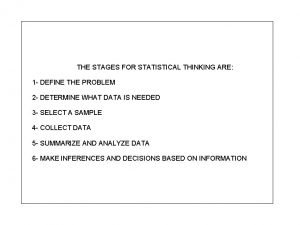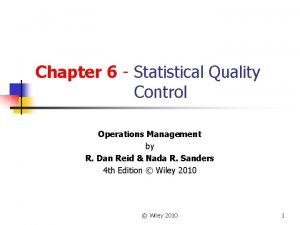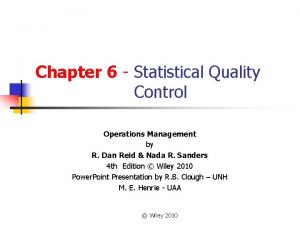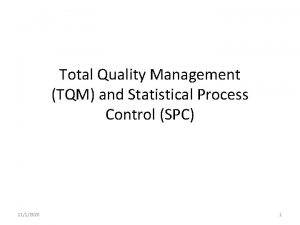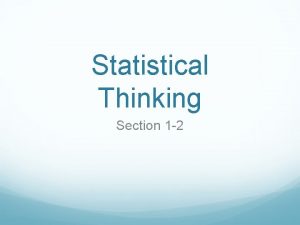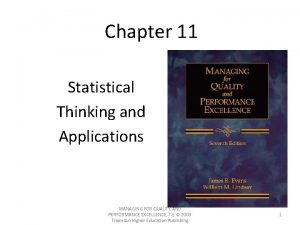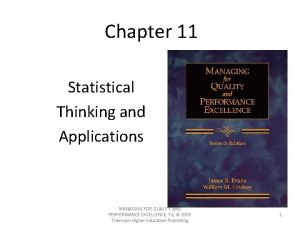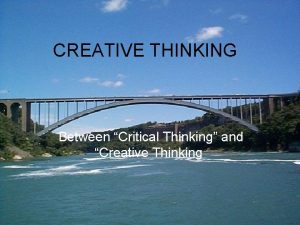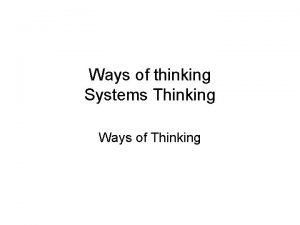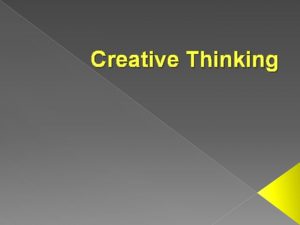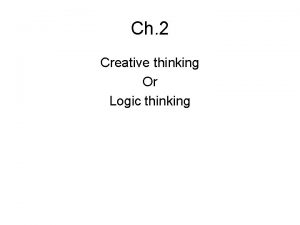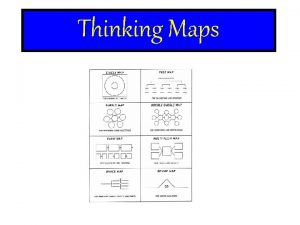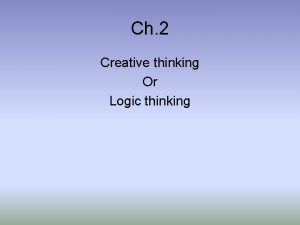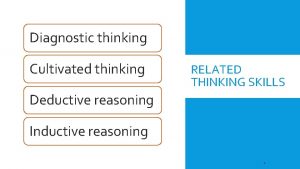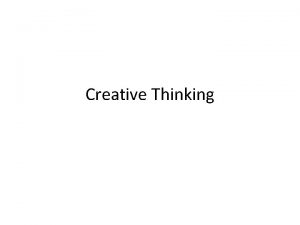Chapter 9 Statistical Thinking and Applications THE MANAGEMENT





























- Slides: 29

Chapter 9 Statistical Thinking and Applications THE MANAGEMENT AND CONTROL OF QUALITY, 5 e, © 2002 South-Western/Thomson Learning. TM 1

Statistical Thinking • All work occurs in a system of interconnected processes • Variation exists in all processes • Understanding and reducing variation are the keys to success THE MANAGEMENT AND CONTROL OF QUALITY, 5 e, © 2002 South-Western/Thomson Learning. TM 2

Sources of Variation in Production Processes Materials INPUTS Tools Operators PROCESS Machines Measurement Instruments Methods OUTPUTS Environment THE MANAGEMENT AND CONTROL OF QUALITY, 5 e, © 2002 South-Western/Thomson Learning. TM Human Inspection Performance 3

Variation • Many sources of uncontrollable variation exist (common causes) • Special (assignable) causes of variation can be recognized and controlled • Failure to understand these differences can increase variation in a system THE MANAGEMENT AND CONTROL OF QUALITY, 5 e, © 2002 South-Western/Thomson Learning. TM 4

Importance of Understanding Variation time PREDICTABLE ? UNPREDECTIBLE THE MANAGEMENT AND CONTROL OF QUALITY, 5 e, © 2002 South-Western/Thomson Learning. TM 5

Two Fundamental Management Mistakes • • Treating as a special cause any fault, complaint, mistake, breakdown, accident or shortage when it actually is due to common causes Attributing to common causes any fault, complaint, mistake, breakdown, accident or shortage when it actually is due to a special cause THE MANAGEMENT AND CONTROL OF QUALITY, 5 e, © 2002 South-Western/Thomson Learning. TM 6

Note to Instructors • The following slides can be used to guide a class demonstration and discussion of the Deming Red Bead experiment using small bags of M&M’s® Chocolate Candies, from a suggestion I found on a TQ newsgroup several years ago. The good output (“red beads”) are the blue M&Ms, with the instructor playing the role of Dr. Deming. THE MANAGEMENT AND CONTROL OF QUALITY, 5 e, © 2002 South-Western/Thomson Learning. TM 7

We’re Going into Business!!! We have a new global customer and have to start up several factories. So I need teams of 5 to do the work: 1 production worker 2 inspectors 1 Chief Inspector 1 Recorder THE MANAGEMENT AND CONTROL OF QUALITY, 5 e, © 2002 South-Western/Thomson Learning. TM 8

Production Setup 1. Take the bag in your left hand. 2. Tear a 3/4” opening in the right corner. (only large enough for one piece at a time) THE MANAGEMENT AND CONTROL OF QUALITY, 5 e, © 2002 South-Western/Thomson Learning. TM 9

Production Process 1. Production worker produces 10 pieces and places them on the napkin. 2. Each inspector, independently, counts the blue ones, and passes to the Chief Inspector to verify. 3. If Chief Inspector agrees, s/he tells the recorder, who reports it to me. THE MANAGEMENT AND CONTROL OF QUALITY, 5 e, © 2002 South-Western/Thomson Learning. TM 10

Do it right the first time! Take Pride in Your Work! Be a Quality Worker! THE MANAGEMENT AND CONTROL OF QUALITY, 5 e, © 2002 South-Western/Thomson Learning. TM 11

Lessons Learned • Quality is made at the top. • Rigid procedures are not enough. • People are not always the main source of variability. • Numerical goals are often meaningless. • Inspection is expensive and does not improve quality. THE MANAGEMENT AND CONTROL OF QUALITY, 5 e, © 2002 South-Western/Thomson Learning. TM 12

Statistical Methods • Descriptive statistics • Statistical inference • Predictive statistics THE MANAGEMENT AND CONTROL OF QUALITY, 5 e, © 2002 South-Western/Thomson Learning. TM 13

Review of Key Concepts • • • Random variables Probability distributions Populations and samples Point estimates Sampling distributions Standard error of the mean THE MANAGEMENT AND CONTROL OF QUALITY, 5 e, © 2002 South-Western/Thomson Learning. TM 14

Important Probability Distributions • Discrete – Binomial – Poisson • Continuous – Normal – Exponential THE MANAGEMENT AND CONTROL OF QUALITY, 5 e, © 2002 South-Western/Thomson Learning. TM 15

Central Limit Theorem • If simple random samples of size n are taken from any population, the probability distribution of sample means will be approximately normal as n becomes large. THE MANAGEMENT AND CONTROL OF QUALITY, 5 e, © 2002 South-Western/Thomson Learning. TM 16

Sampling Methods • • • Simple random sampling Stratified sampling Systematic sampling Cluster sampling Judgment sampling THE MANAGEMENT AND CONTROL OF QUALITY, 5 e, © 2002 South-Western/Thomson Learning. TM 17

Sampling Error • Sampling error (statistical error) • Nonsampling error (systematic error) • Factors to consider: – Sample size – Appropriate sample design THE MANAGEMENT AND CONTROL OF QUALITY, 5 e, © 2002 South-Western/Thomson Learning. TM 18

Design of Experiments • A test or series of tests to compare two or more methods to determine which is better, or to determine levels of controllable factors to optimize the yield of a process or minimize the variability of a response variable. • Factorial experiment – Analysis of all combinations of factor levels to understand main effects and interactions THE MANAGEMENT AND CONTROL OF QUALITY, 5 e, © 2002 South-Western/Thomson Learning. TM 19

Excel Descriptive Statistics Tool • Tools…Data Analysis… Descriptive Statistics THE MANAGEMENT AND CONTROL OF QUALITY, 5 e, © 2002 South-Western/Thomson Learning. TM 20

THE MANAGEMENT AND CONTROL OF QUALITY, 5 e, © 2002 South-Western/Thomson Learning. TM 21

Excel Histogram Tool • Tools…Data Analysis…Histogram THE MANAGEMENT AND CONTROL OF QUALITY, 5 e, © 2002 South-Western/Thomson Learning. TM 22

THE MANAGEMENT AND CONTROL OF QUALITY, 5 e, © 2002 South-Western/Thomson Learning. TM 23

Process Capability • The range over which the natural variation of a process occurs as determined by the system of common causes • Measured by the proportion of output that can be produced within design specifications THE MANAGEMENT AND CONTROL OF QUALITY, 5 e, © 2002 South-Western/Thomson Learning. TM 24

Types of Capability Studies • Peak performance study - how a process performs under ideal conditions • Process characterization study - how a process performs under actual operating conditions • Component variability study - relative contribution of different sources of variation (e. g. , process factors, measurement system) THE MANAGEMENT AND CONTROL OF QUALITY, 5 e, © 2002 South-Western/Thomson Learning. TM 25

Process Capability Study • • Choose a representative machine or process Define the process conditions Select a representative operator Provide the right materials Specify the gauging or measurement method Record the measurements Construct a histogram and compute descriptive statistics: mean and standard deviation Compare results with specified tolerances THE MANAGEMENT AND CONTROL OF QUALITY, 5 e, © 2002 South-Western/Thomson Learning. TM 26

Process Capability (a) specification natural variation (c) specification natural variation (b) specification natural variation (d) specification natural variation THE MANAGEMENT AND CONTROL OF QUALITY, 5 e, © 2002 South-Western/Thomson Learning. TM 27

Process Capability Index Cp = UTL - LTL 6 s Cpu = UTL - m 3 s Cpl = m - LTL 3 s Cpk = min{ Cpl, Cpu } THE MANAGEMENT AND CONTROL OF QUALITY, 5 e, © 2002 South-Western/Thomson Learning. TM 28

PROCESS_CAPABILITY. XLS THE MANAGEMENT AND CONTROL OF QUALITY, 5 e, © 2002 South-Western/Thomson Learning. TM 29
 Statistical thinking definition
Statistical thinking definition Positive thinking vs negative thinking examples
Positive thinking vs negative thinking examples Thinking about your own thinking
Thinking about your own thinking Holistic judgement
Holistic judgement Perbedaan critical thinking dan creative thinking
Perbedaan critical thinking dan creative thinking Thinking about you thinking about me
Thinking about you thinking about me Sqc of filling processes
Sqc of filling processes Statistical quality control in operations management
Statistical quality control in operations management Airline ticket
Airline ticket Sport management principles and applications
Sport management principles and applications Hình ảnh bộ gõ cơ thể búng tay
Hình ảnh bộ gõ cơ thể búng tay Ng-html
Ng-html Bổ thể
Bổ thể Tỉ lệ cơ thể trẻ em
Tỉ lệ cơ thể trẻ em Gấu đi như thế nào
Gấu đi như thế nào Thang điểm glasgow
Thang điểm glasgow Chúa yêu trần thế alleluia
Chúa yêu trần thế alleluia Môn thể thao bắt đầu bằng từ đua
Môn thể thao bắt đầu bằng từ đua Thế nào là hệ số cao nhất
Thế nào là hệ số cao nhất Các châu lục và đại dương trên thế giới
Các châu lục và đại dương trên thế giới Công của trọng lực
Công của trọng lực Trời xanh đây là của chúng ta thể thơ
Trời xanh đây là của chúng ta thể thơ Mật thư anh em như thể tay chân
Mật thư anh em như thể tay chân 101012 bằng
101012 bằng Phản ứng thế ankan
Phản ứng thế ankan Các châu lục và đại dương trên thế giới
Các châu lục và đại dương trên thế giới Thơ thất ngôn tứ tuyệt đường luật
Thơ thất ngôn tứ tuyệt đường luật Quá trình desamine hóa có thể tạo ra
Quá trình desamine hóa có thể tạo ra Một số thể thơ truyền thống
Một số thể thơ truyền thống Cái miệng xinh xinh thế chỉ nói điều hay thôi
Cái miệng xinh xinh thế chỉ nói điều hay thôi
